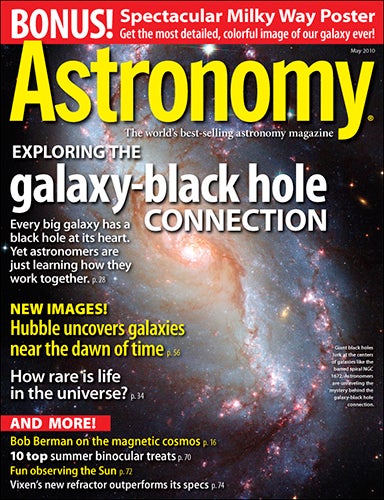
Editor David J. Eicher gives a video tour of the May 2010 issue
WAUKESHA, Wis. — As hard as it may be to fully understand family dynamics in humans, some cosmic families have proven even harder to comprehend. One such relationship is the possible one between large galaxies and the supermassive black holes that have turned out always to lurk in their centers.
In “Exploring the galaxy-black hole connection,” Contributing Editor Steve Nadis explains the history behind this unexpected link and several competing theories as to why it exists. Although astronomers have worked on this problem for almost 2 decades, no clear consensus has yet emerged.
“[University of Michigan astronomer Douglas] Richstone regards the current state of affairs as an ‘interesting mess,’ ” Nadis writes. “Scientists are learning plenty of new things, and some of them might lead to an answer, [Richstone] says.” Whatever the case, the tremendous amount scientists are learning about galactic dynamics ensures that the journey to find the answers will be as revealing as the answers themselves.
Pick up the May issue of Astronomy, on newsstands April 6, to learn the details of current theories that explain the connection and what they mean for galactic evolution.
“The new search for life in the universe”
As astrobiologist Christopher Chyba writes, “For thousands of years, people have wondered if there are other worlds like Earth that support living organisms.” Even though we’re still not certain of the answer, the Princeton professor explains just what made life on Earth successful and how we can use that knowledge to better search the cosmos for similar environments. Whether or not life exists elsewhere may be just as important as understanding why.
“Vixen’s new refractor outperforms its specs”
Contributing Editor and Columnist Glenn Chaple’s first foray into high-end observing leaves him “spoiled” for the razor-sharp, flawless, and sleek optics of this “Ferrari” of telescopes, Vixen’s AX103S.
“Axel Mellinger’s Milky Way mosaic”
Gaze upon our Milky Way Galaxy as never before with this bonus poster foldout displaying thousands of famed astrophotographer Axel Mellinger’s images in a huge, seamless mosaic. The result is unique in both its scientific value and its esthetic beauty.
Also in the May 2010 Astronomy
- “Galaxies near the dawn of time” — The Hubble Space Telescope’s latest and greatest deep-field image uncovers a population of distant and ancient galaxies more than 13 billion light-years from Earth.
- “Target 30 obscure celestial gems” — This list of faint, fainter, and faintest deep-sky targets will take your observing to the next level.
- “Fun observing the Sun” — Double your observing time by targeting our daytime star.
- “The Sky This Month” — Exclusive pullout star charts will guide you through May’s night sky.
- The May issue of Astronomy also includes Astro News, Beautiful Universe, Bob Berman’s Strange Universe, Glenn Chaple’s Observing Basics, David H. Levy’s Evening Stars, Stephen James O’Meara’s Secret Sky, Ask Astro, Astro Confidential, Deep-sky Showcase, Telescope Insider, New Products, Reader Gallery, and The Cosmic Grid.









